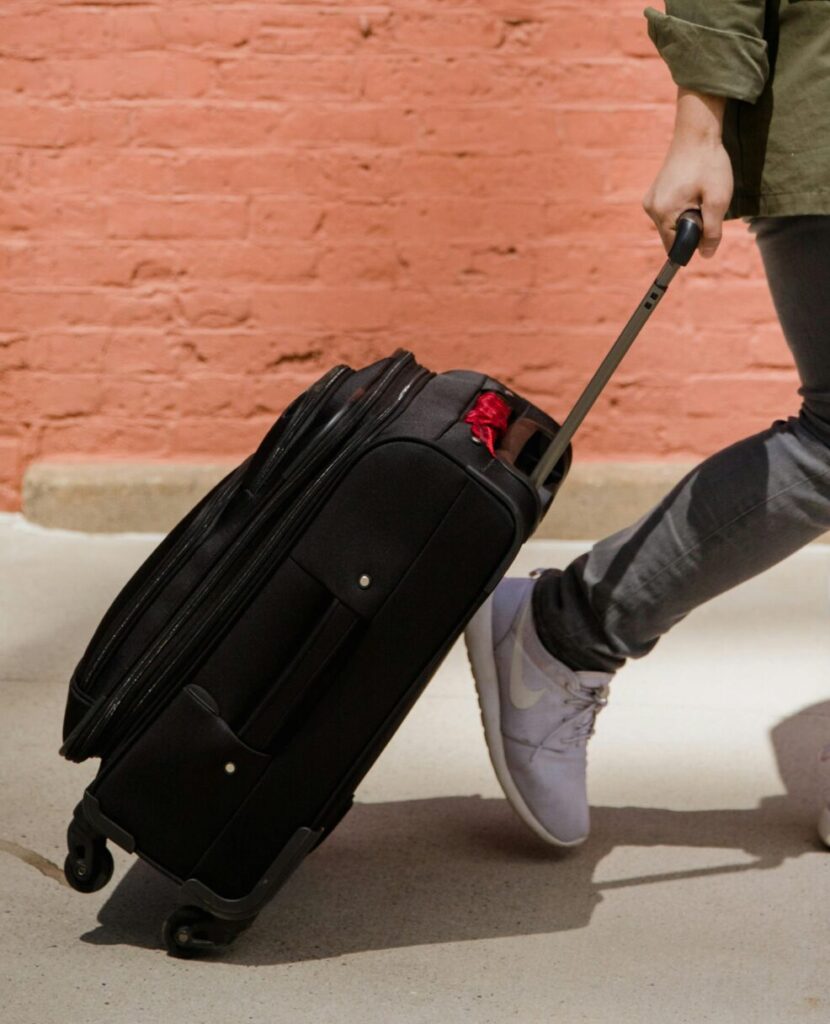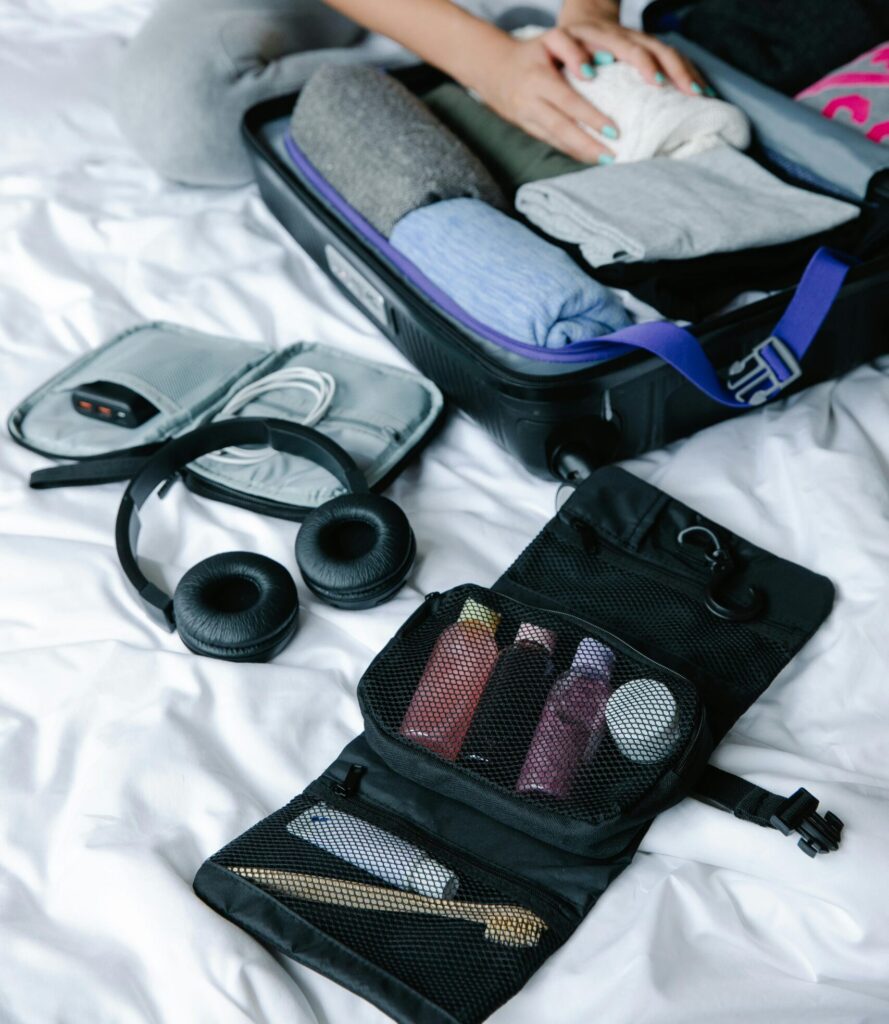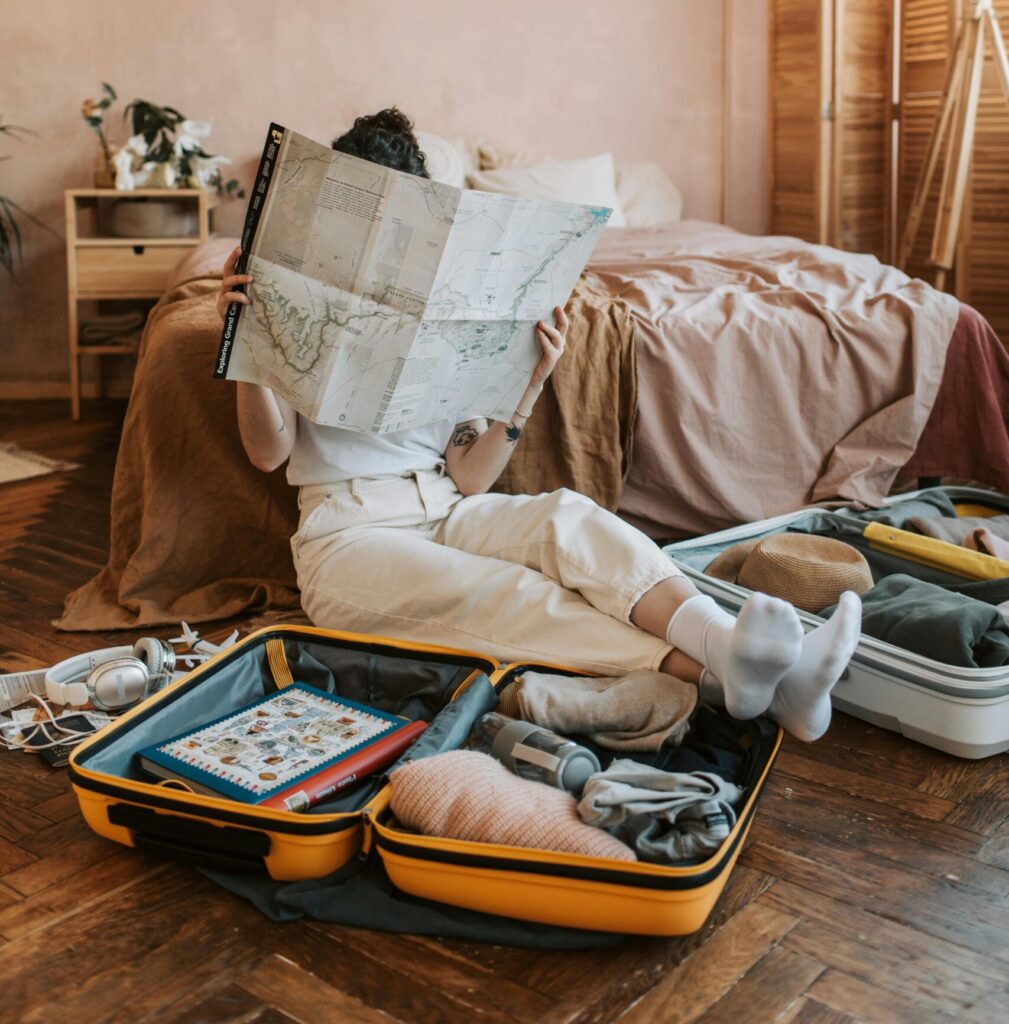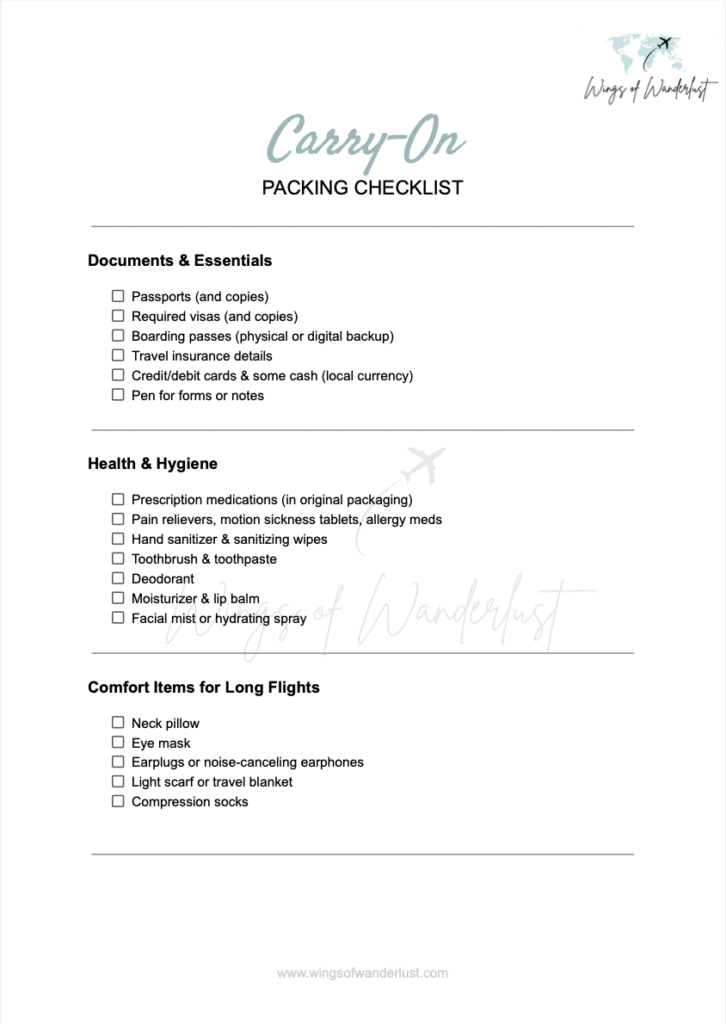Packing your carry-on correctly can make the difference between a stress-free trip and a frustrating one. This guide covers what to pack in a carry-on bag for a flight, what not to pack, and even tips for long-haul comfort. Plus, we’ll help you understand the difference between carry-on and checked luggage, share the most common airline regulations, and provide a free downloadable checklist to make packing easier.
- Understanding Luggage Types and Airline Rules
- Travel Documents and Essentials
- Health and Hygiene Items
- Comfort Essentials for Long Flights
- Tech and Power Must-Haves
- Snacks and Hydration
- Clothing and Small Extras
- What Not to Pack in Your Carry-On Bag
- General Airline Regulations to Remember
- Bonus Packing Tips
- Download Your Free Carry-On Packing Checklist
- Conclusion
Understanding Luggage Types and Airline Rules
Before you start packing, it’s important to understand the basics of airline luggage categories:
- Carry-on luggage is the small bag or suitcase you take into the cabin. Most airlines limit it to around 7–10 kg (15–22 lbs) and specific dimensions like 22 x 14 x 9 inches (56 x 36 x 23 cm).
- Personal item includes a backpack, purse, or laptop bag that fits under the seat in front of you.
- Checked luggage is stored in the aircraft’s cargo hold. It usually allows more weight (20–30 kg), but you don’t have access to it during the flight.

Basically, carry-on luggage is the bag or suitcase you carry onto the plane with you. It’s important to know that it’s also the luggage you take with you through airport security. That’s why it’s crucial to understand what you can and should pack, and what you must not.
Always check your airline’s specific rules before packing, as dimensions and weight allowances can vary between carriers and ticket types. Low-cost airlines often have stricter restrictions or additional fees for larger carry-ons.
What to Pack in a Carry-On Bag for a Flight:
Travel Documents and Essentials
Your travel documents should always be the first things you pack in your carry-on. Keep these in an easy-to-reach pouch or organizer:
- Passport and visas (and photocopies or digital backups)
- Boarding passes
- Travel insurance details
- Credit cards and some cash in local currency
- A pen for customs or immigration forms
Extra tip: Having everything in one dedicated travel wallet prevents frantic searching during boarding or at checkpoints.

Health and Hygiene Items
Long flights and busy airports can take a toll on your body, so having a well-stocked health kit is essential. Include:
- Prescription medications in original packaging
- Pain relief, motion sickness tablets, and allergy meds
- Sanitizing wipes and hand sanitizer
- Travel-sized toothpaste, toothbrush, and deodorant
Extra tip: Cabin air is notoriously dry, so it’s also recommended to pack moisturizer, lip balm, and hydrating mist to stay comfortable.

Comfort Essentials for Long Flights
If you’re flying long-haul, packing comfort items can turn hours of discomfort into a restful journey. Make sure to pack:
- A neck pillow and eye mask to make sleeping in tight spaces more bearable.
- Compression socks will help with circulation and reduce swelling during long periods of sitting.
- Bring a light scarf or travel blanket, especially for flights where cabin temperatures vary.
- Load your tablet or phone with offline entertainment: movies, podcasts, and e-books, to pass the time.
Tech and Power Must-Haves
Modern travel depends on staying connected, so keep your tech gear ready in your carry-on:
- Portable power bank (within allowed battery limits – check with your air carrier)
- Charging cables and a universal power adapter for international flights
- Noise-canceling headphones to block engine noise and chatter
Keeping your devices charged and ready makes navigating airports and finding your way at your destination far easier.
Snacks and Hydration
Airport food can be expensive and unhealthy, so bringing your own snacks is a smart move. Therefore:
- Pack dry, non-liquid snacks like nuts, granola bars, or sandwiches.
- An empty reusable water bottle can be filled after security, helping you stay hydrated throughout the flight.
Pro tip: Avoid very salty snacks, as they can increase dehydration.
Clothing and Small Extras
Delays happen, and sometimes checked luggage doesn’t arrive when you do. So always keep a small change of clothes in your carry-on:
- Fresh shirt or top
- Clean underwear and socks
- Lightweight sweater or jacket
This way, you can feel refreshed if your bags are delayed or if you have an unexpected layover.

What Not to Pack in Your Carry-On Bag
Understanding what not to pack in a carry-on bag for a flight can help you avoid security issues and delays. Prohibited items include:
- Liquids over 3.4 oz (100 ml); unless medically necessary
- Sharp objects like knives, scissors, or razors
- Large batteries or power banks over airline limits – check with your airline
- Flammable materials, fireworks, or aerosol sprays
Always review the TSA or local security regulations before your trip, and double-check your airline’s prohibited items list.
General Airline Regulations to Remember
- Weight and size limits vary by airline. Check before packing to avoid extra fees.
- Liquids follow the 3-1-1 rule: one quart-sized clear bag, 3.4 oz per container.
- Duty-free liquids over 3.4 oz must be sealed in a tamper-proof bag with a receipt.
- Some airlines have some extra restrictions, especially in Europe and Asia, so check them before traveling.
Bonus Packing Tips
- Use packing cubes to organize items and maximize space.
- Wear your bulkiest layers on the plane to save room in your carry-on.
- Keep valuables like jewelry or electronics in your carry-on, never in checked bags.
- Download maps and language apps offline in case Wi-Fi is spotty.
Download Your Free Carry-On Packing Checklist
To make your trip preparation even easier, download our free printable carry-on packing checklist. It includes must-have items, prohibited items, and space for your own notes.
Having a checklist ensures you won’t forget travel essentials or accidentally pack something that could get confiscated.

Conclusion
Packing your carry-on bag doesn’t have to be stressful. With a clear plan and this checklist, you can stay organized, avoid overpacking, and make your trip more enjoyable. Always double-check your airline’s regulations, especially for size, weight, and prohibited items, to avoid surprises at the airport. Download the editable checklist to customize it for each trip, and travel with confidence, knowing you have everything you need right at your fingertips.


Leave a Reply